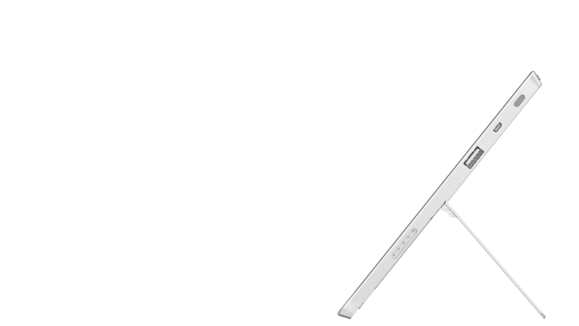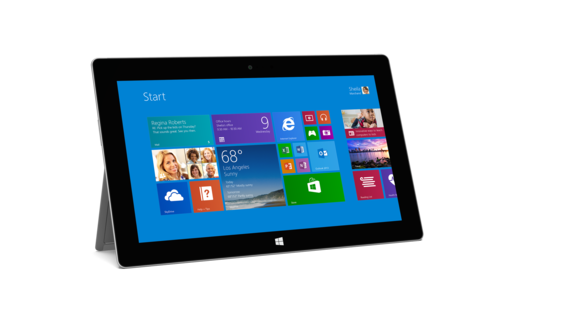Microsoft’s long-rumored Surface refresh became reality on Monday, and the revamped Surface Pro 2 shows that Microsoft has been listening to customer complaints. Relative to the original Pro model, the second-generation Pro is vastly more powerful, packs better speakers, and lasts longer on a charge, offering more than 10 hours of battery life when paired with a new Power Cover.
The company has even introduced a new docking-station accessory that lets you convert the Surface Pro 2 from a laptop/tablet hybrid into a full-fledged workstation. Basically, it feels wonderful, and it should be a tremendous improvement over its already impressive predecessor.
Too bad you can’t say the same for the Surface 2 tablet.
Despite the fresh name and a handful of helpful tweaks, the Surface 2 is still saddled with the same ho-hum value proposition and half-baked Windows RT operating system as the original Surface RT—a disaster that ended up costing Microsoft nearly $1 billion in write-downs. The Surface 2 doesn’t look any more appealing.
Refining the wheel
“Surface has been one of the best products that Microsoft has ever built,” Surface honcho Panos Panay said at the launch event. “Reinventing the wheel is not the goal. Making it better is.”
Oh, and you can get it in silver now. And did we mention the plethora of handy-dandy Surface accessories, such as the battery-boosting Power Cover and the music-minded Remix Cover?
All are solid, welcome improvements. But none fix the core issues that doomed the first round of Surface RT tablets.
Rotten at its core
As fast and as pretty as the Surface 2 is, it still runs Windows RT. Designed for use on tablets with ARM processors, the Windows RT operating system is a crippled mess capable of running only Microsoft’s touch-friendly modern apps. Traditional desktop apps simply don’t function in Windows RT, despite the fact that a vestigial desktop lingers in the operating system. Except for Dell, every third-party PC maker abandoned Microsoft’s Windows RT vision over the past year.The original version of Windows RT (and hence the Surface RT) had some glaring interface issues. The impending Windows RT 8.1 update found in the Surface 2 corrects most of those, but it can’t address Windows RT’s biggest problem: a lack of useful apps.
 Photo: Caitlin McGarry
Photo: Caitlin McGarryUnfortunately, we examined the state of the Windows Store in depth when Microsoft first trumpeted its breaking the 100,000-app barrier in July, and while we found the game and streaming-video genres to be well represented, the rest of the ecosystem is woefully underdeveloped. That isn’t such a big deal on Windows 8 devices, which can use traditional desktop apps, but it’s a massive problem for Windows RT. Worse, some of the big-name apps promised at July’s Build conference—most notably Facebook and Flipboard—have yet to appear in the Windows Store.
Yes, the Surface 2 will have some appeal to niche users who thirst for portable productivity, largely because it bundles the Office suite in a long-lasting package. But that alone won’t win over the masses, as the failure of the first Surface RT proved—especially considering the next factor.
Shallow use, steep price
The Surface 2 is $450—a cost that represents a $50 discount off the original iteration, but still puts the tablet in the pricing stratosphere alongside the iPad.
Although there’s no question that the Surface is beautifully designed, it simply doesn’t have anywhere near the robust app ecosystem or basic value proposition of the iPad. Asking $450 for the Surface 2 is sheer madness, especially since that price doesn’t even include the must-have Touch Cover or Type Cover so integral to the Surface experience. (The cost for a cover is an extra $120 or $130, respectively.) Great Android tablets, meanwhile, can be had for around $200.
“I understand Microsoft thinks they are making Surface 2 more valuable with Office RT and other interesting services, but they are in a market competing with $200 Android tablets and even the $329 iPad mini,” Mainelli said.
People aren’t afraid to buy the Surface. Indeed, the Surface RT started flying off store shelves when it was reduced to $350. But history has shown that people won’t pay iPad prices for Microsoft’s ARM tablet, and that isn’t likely to change until the Windows Store matures.
Large and not in charge

Despite Microsoft’s productivity push, Windows RT is better suited for consumptive tasks thanks to its sole focus on the finger-friendly modern UI—and people looking to immerse themselves in content are buying diminutive tablets, not large ones. Our time with the 8-inch Acer Iconia W3 proved that miniature Windows tablets can be surprisingly useful. Rumors suggest that a “Surface mini” is on the way, but the Surface 2 seems just as awkwardly positioned as its predecessor.
Better in every way but the ones that count
Faster, “sexier” (as Panay dubs it) hardware always helps, but glitz and glamor can’t rescue a fundamentally underwhelming user experience. The Surface 2 proves that Microsoft’s device team can design some truly impressive hardware, yet with Windows RT at its core and a sky-high sticker price, the Surface 2 seems poised to repeat the failures of its forefathers.The Surface Pro 2, on the other hand, looks like it could be a truly appealing option for business or graphics professionals seeking one device to rule them all. But that’s another story for another day.




 18:39
18:39
 ram
ram





















